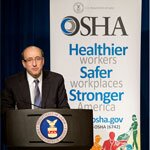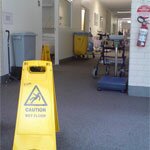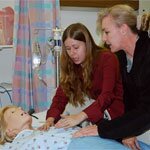Congress established the Occupational Safety and Health Administration (OSHA) through the Occupational Safety and Health Act of 1970s. As part of the United States Department of Labor, OSHA’s mission is to “assure safe and healthful working conditions for working men and women by setting and enforcing standards and by providing training, outreach, education and assistance.” Learn how OSHA has grown over the decades, and how their activities pertain to health administration in this country, especially within hospitals.
OSHA’s Reach

OSHA enforces its standards on regulated entities and sends Compliance Safety and Health Officers to work sites, where they carry out inspections and assess fines for:
- Regulatory violations
- Inspections are planned for work sites in particularly hazardous industries.
- Inspections that result in response to workplace incidents, worker complaints, or referrals by other individuals.
Most employees in the nation come under OSHA’s jurisdiction, as OSHA covers private sector employers and employees in all 50 states, the District of Columbia, and other U.S. jurisdictions. these industries are affected either through Federal OSHA or through an OSHA-approved state program. OSHA covers approximately 7 million workplaces.
Certain workplaces are exempted from OSHA inspections because they fall outside of the scope of the Occupational Safety and Health Act, are regulated by other agencies, or are exempted through Department of Labor appropriations bills. Exempted workers include:
- Mine and quarry workers (regulated by the Mine Safety and Health Administration, or MSHA)
- Independent contractors and other self-employed individuals
- Public sector employees (covered only in jurisdictions with state plans; the United States Postal Service is covered under the Postal Employees Safety Enhancement Act)
- Domestic workers
- Flight crews (covered by the Federal Aviation Administration, or FAA)
Additionally, workplaces participating in OSHA’s Voluntary Protection Programs are exempted from programmatic inspections, though they can still be subject to inspections. However, OSHA does pay attention to hospitals, including administrations, employees, and patients.
The Hospital Focus

OSHA pays special attention to hospitals through several tools, including the Hospital eTool. This tool covers various topics, including heliports, housekeeping, pharmacies, surgery, laboratories, and administration. OSHA uses interactive web-based training tools that enable users to answer questions and receive reliable answers about regulations that might apply to a work site. Under the administration link, OSHA addresses:
- Safety and Health Program: OSHA addresses the Voluntary Protection Program and how it helps to keep employees safe. They also point to the U.S. Department of Health and Human Services’ (HHS) guidelines for protecting health care workers.
- Regulatory/Organizational Agencies: OSHA lists a number of agencies that administrators can use to regulate safety standards, including The Centers for Disease Control and Prevention (CDC) and the National Institute for Occupational Safety and Health (NIOSH).
- Trade Organizations: Currently, OSHA lists five trade organizations that can support hospital administrations in developing safety programs, including the American Society for Healthcare Risk Management (ASHRM), which is the preeminent society for healthcare risk management.
- Admissions and Records: The major issues addressed here include muscle-related musculoskeletal disorders (MSDs) and workplace violence.
- Computer Workstations: Again, OSHA addresses MSD and provides solutions to help remedy that issue.
- Carbonless Paper: Carbonless paper is used everyday for checks, credit-card receipts and medical forms. Tiny micro granules of dyes and resins are released when sheets are pressed together and can be absorbed through the skin or released into the air and inhaled resulting in mild to moderate symptoms of skin irritation and irritation of the mucosal membranes of the eyes and upper respiratory tract. OSHA provides solutions for this issue.
- Employee/Employer Rights: This is a reminder to assure that employees and employers know their rights before, during, and after an OSHA inspection.
OSHA and Health Administration

Health administrators, in keeping with the spirit of a healthy community, are included in OSHA’s plan for safe employee environments for employees and for patients. OSHA standards consider the amount of hazardous chemicals workers can be exposed to, the use of certain safe practices and equipment, and require employers to monitor hazards and keep records of workplace injuries and illnesses. Examples of OSHA standards include requirements to:
- provide fall protection
- prevent trenching cave ins
- prevent some infectious diseases
- assure that workers safely enter confined spaces
- prevent exposure to harmful substances like asbestos
- put guards on machines
- provide respirators or other safety equipment
- provide training for certain dangerous jobs
Employers must also comply with the General Duty Clause of the OSH Act, which requires employers to keep their workplace free of serious recognized hazards. This clause is generally cited when no OSHA standard applies to the hazard.
Other OSHA concerns for the hospital industry include:
- The Control of Hazardous Energy (Lockout/Tagout): OSHA requires specific “lockout” procedures to safeguard employees from the unexpected energization (start-up) or release of hazardous energy from machinery and equipment.
- Permit-Required Confined Spaces: Hospitals must follow OSHA’s regulations for spaces that have limited or restricted means for entry and exit, and are not designed for continuous employee occupancy.
- Walking-Working Surfaces: To prevent injuries, OSHA requires hospitals to maintain clean, dry surfaces throughout their facility, with strict requirements for how to handle wet floors, spills and clutter.
- Hazard Communication: If hazardous chemicals are present, hospitals must have information available that identifies the chemicals and warns employees about the potential hazards.
- Means of Egress and NFPA 101 Life Safety Code: Hospitals must have a safe exit route to ensure that their employees and patients can safely and quickly find their way out during a fire and similar emergency.
OSHA even provides a lengthy review on how hospital-based first receivers of victims from mass casualty incidents involving the release of hazardous substances might act.
Keeping in Line with OSHA
Violations of any OSHA guideline or regulation can result in fines. Some of the most costly hospital OSHA fines [PDF] against hospitals included $2,100 for contaminated equipment, $7,000 for failure to fully report and exposure incident, and $7,500 for lack of employee training. Hospitals can save themselves precious money from having to be spent on fines by being in compliance with the standard. The most important reason, however, to be in compliance with the standard is to provide a safe environment that will help to obtain and retain qualified healthcare workers.
Stay on top of OSHA standards for hospitals and health care, as the resources they offer to help keep communities healthy are invaluable tools to maintain hospital standards.


